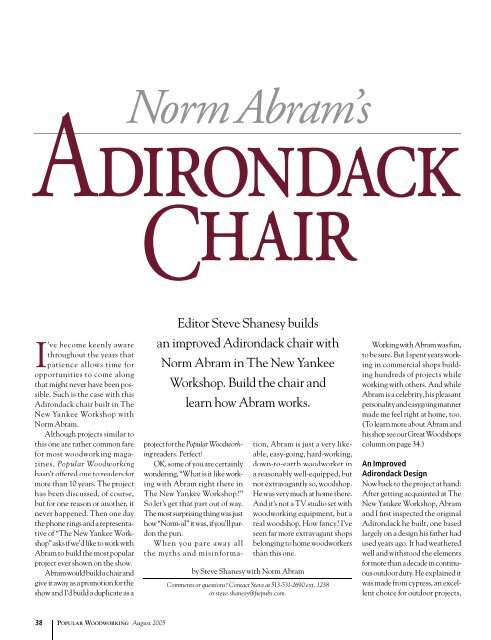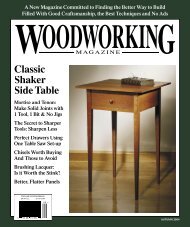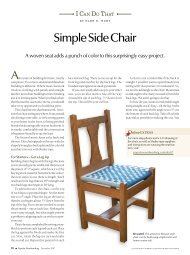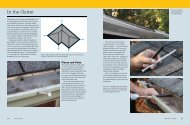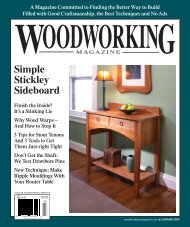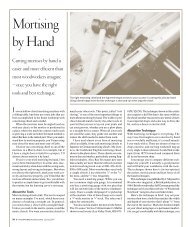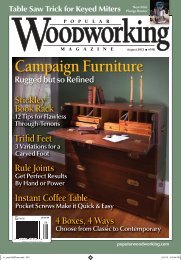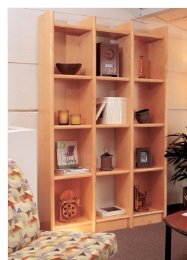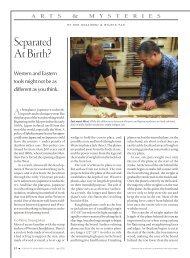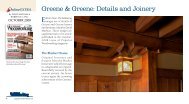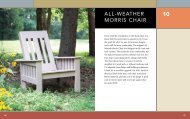Norm Abram's - Popular Woodworking Magazine
Norm Abram's - Popular Woodworking Magazine
Norm Abram's - Popular Woodworking Magazine
Create successful ePaper yourself
Turn your PDF publications into a flip-book with our unique Google optimized e-Paper software.
<strong>Norm</strong> Abram’s<br />
ADIRONDACK<br />
CHAIR<br />
I’ve become keenly aware<br />
throughout the years that<br />
patience allows time for<br />
opportunities to come along<br />
that might never have been possible.<br />
Such is the case with this<br />
Adirondack chair built in The<br />
New Yankee Workshop with<br />
<strong>Norm</strong> Abram.<br />
Although projects similar to<br />
this one are rather common fare<br />
for most woodworking magazines,<br />
<strong>Popular</strong> <strong>Woodworking</strong><br />
hasn’t offered one to readers for<br />
more than 10 years. The project<br />
has been discussed, of course,<br />
but for one reason or another, it<br />
never happened. Then one day<br />
the phone rings and a representative<br />
of “The New Yankee Workshop”<br />
asks if we’d like to work with<br />
Abram to build the most popular<br />
project ever shown on the show.<br />
Abram would build a chair and<br />
give it away as a promotion for the<br />
show and I’d build a duplicate as a<br />
Editor Steve Shanesy builds<br />
an improved Adirondack chair with<br />
<strong>Norm</strong> Abram in The New Yankee<br />
Workshop. Build the chair and<br />
learn how Abram works.<br />
project for the <strong>Popular</strong> Woodwork-<br />
ing readers. Perfect!<br />
OK, some of you are certainly<br />
wondering, “What is it like working<br />
with Abram right there in<br />
The New Yankee Workshop?”<br />
So let’s get that part out of way.<br />
The most surprising thing was just<br />
how “<strong>Norm</strong>-al” it was, if you’ll pardon<br />
the pun.<br />
When you pare away all<br />
the myths and misinformation,<br />
Abram is just a very likeable,<br />
easy-going, hard-working,<br />
down-to-earth woodworker in<br />
a reasonably well-equipped, but<br />
not extravagantly so, woodshop.<br />
He was very much at home there.<br />
And it’s not a TV studio set with<br />
woodworking equipment, but a<br />
real woodshop. How fancy? I’ve<br />
seen far more extravagant shops<br />
belonging to home woodworkers<br />
than this one.<br />
by Steve Shanesy with <strong>Norm</strong> Abram<br />
Comments or questions? Contact Steve at 513-531-2690 ext. 1238<br />
or steve.shanesy@fwpubs.com.<br />
Working with Abram was fun,<br />
to be sure. But I spent years working<br />
in commercial shops building<br />
hundreds of projects while<br />
working with others. And while<br />
Abram is a celebrity, his pleasant<br />
personality and easygoing manner<br />
made me feel right at home, too.<br />
(To learn more about Abram and<br />
his shop see our Great Woodshops<br />
column on page 34.)<br />
An Improved<br />
Adirondack Design<br />
Now back to the project at hand:<br />
After getting acquainted at The<br />
New Yankee Workshop, Abram<br />
and I fi rst inspected the original<br />
Adirondack he built, one based<br />
largely on a design his father had<br />
used years ago. It had weathered<br />
well and withstood the elements<br />
for more than a decade in continuous<br />
outdoor duty. He explained it<br />
was made from cypress, an excellent<br />
choice for outdoor projects,<br />
38<br />
POPULAR WOODWORKING August 2005
Photos by Al Parrish
and he had laid in a supply for our<br />
new chairs.<br />
We next reviewed the chair<br />
plans, one of those famous “measured<br />
drawr-ings” Abram offers<br />
viewers at the conclusion of each<br />
show. This copy had some notes<br />
about minor modifications Abram<br />
intended as improvements. The<br />
last thing we did before cutting<br />
wood was review several templates<br />
he made for the original chair<br />
and saved throughout the years.<br />
We used these patterns for the<br />
curved parts. Drawings for these<br />
are included as part of the project<br />
plans presented here.<br />
If you begin the project by preparing<br />
the patterns and stock to<br />
the rough sizes the building will<br />
move along pretty quickly. We<br />
completed our chairs in less than a<br />
day while working at a steady, but<br />
moderately easy, pace.<br />
<br />
Starting at the Bottom<br />
Essentially, this chair is built from<br />
the ground up so the fi rst pieces<br />
required are the two side members<br />
that slope back from the front, vertical<br />
legs. Use the pattern to trace<br />
their shape on the stock, then<br />
cut them out using the band saw.<br />
Abram suggested we nail the two<br />
sides together at the ends in the<br />
waste material and stack cut them<br />
both to save some time. Then we<br />
drum-sanded the sawn edges to<br />
smooth the surface.<br />
Next use a gauge block and a<br />
miter saw or table saw so you can<br />
repeat the same length cut exactly<br />
for the lower rear crosspiece, the<br />
front crosspiece and the seat slats.<br />
Use the pattern that provides the<br />
curved shape of the lower rear<br />
crosspiece. (Abram’s frugal, Yankee<br />
blood became evident when he<br />
pointed out that by using slightly<br />
wider stock than necessary for this<br />
part, the waste piece makes the<br />
perfect matched curve needed<br />
<br />
<br />
<br />
<br />
for the rear seat slat.) After band<br />
sawing, sand the edges smooth<br />
and be sure to set the waste piece<br />
aside for later use.<br />
A Little Assembly Work<br />
The fi rst assembly chore is joining<br />
the two sides with the front<br />
and lower rear crosspieces. The<br />
crosspieces overlap the sides and<br />
care should be taken that the ends<br />
are fl ush to the outside edges of<br />
the sides. This will help keep your<br />
chair square as you build.<br />
The chair parts are assembled<br />
using mostly screws, or in a few<br />
Cut both chair<br />
side pieces at<br />
the same time<br />
by nailing them<br />
together in a<br />
waste section<br />
of wood. Band<br />
saw to the template<br />
line then<br />
sand the edges<br />
smooth.<br />
instances, carriage bolts, nuts and<br />
washers. We used stainless steel<br />
fasteners knowing they’d stand<br />
up to the rigors of life outdoors.<br />
These are more expensive than<br />
coated or plated fasteners, but<br />
in the end are a far better value.<br />
Screw lengths are 1 5⁄ 5 8 " except<br />
where noted. We also used outdoor<br />
adhesives. Abram used 3M<br />
brand Marine Adhesive Sealant<br />
5200. Because my chair would be<br />
shipped to the <strong>Popular</strong> Woodwork-<br />
ing<br />
shop in Ohio, I just screwed my<br />
parts together so it could be disassembled<br />
and more easily shipped.<br />
<br />
<br />
<br />
<br />
<br />
<br />
<br />
<br />
<br />
<br />
NORM ABRAM’S ADIRONDACK CHAIR<br />
NO. ITEM DIMENSIONS (INCHES) MATERIAL COMMENTS<br />
T W L<br />
❏ 2 Side members 3⁄ 3 4 5 1 ⁄ 2 34 3⁄ 3 4 Cypress<br />
❏ 1 Lower rear 3⁄ 3 4 5 1 ⁄ 2 22 Cypress Use waste for<br />
crosspiece<br />
rear seat slat<br />
❏ 1 Front 3⁄ 3 4 3 1 ⁄ 2 22 Cypress<br />
crosspiece<br />
❏ 2 Front legs 3⁄ 3 4 3 1 ⁄ 2 23 1 ⁄ 4 Cypress<br />
❏ 2 Arm brackets 3⁄ 3 4 3 6 5⁄ 5 8 Cypress<br />
❏ 2 Arms 3⁄ 3 4 5 27 9⁄ 9 16 Cypress<br />
❏ 1 Upper rear 3⁄ 3 4 4 5⁄ 5 16 26 1 ⁄ 4 Cypress<br />
crosspiece<br />
❏ 1 Center back slat 3⁄ 3 4 3 1 ⁄ 2 30 3⁄ 3 4 Cypress<br />
❏ 2 Intermediate 3⁄ 3 4 3 1 ⁄ 2 29 5⁄ 5 8 Cypress<br />
back slats<br />
❏ 2 Outer back slats 3⁄ 3 4 3 1 ⁄ 2 25 1 ⁄ 4 Cypress<br />
❏ 5 Seat slats 3⁄ 3 4 2 1 ⁄ 2 22 Cypress<br />
40<br />
POPULAR WOODWORKING August 2005
1 square = 1"<br />
<br />
<br />
<br />
<br />
<br />
Outer back slat Intermediate back slat Center back slat Arm bracket<br />
<br />
<br />
<br />
<br />
<br />
<br />
<br />
Side member<br />
<br />
<br />
<br />
<br />
Upper rear crosspiece<br />
<br />
<br />
<br />
Arm<br />
<br />
<br />
<br />
<br />
<br />
<br />
<br />
<br />
<br />
Lower rear crosspiece & rear seat slat<br />
<br />
popwood.com 41
Start the assembly<br />
by gluing and<br />
screwing the<br />
lower rear crosspiece<br />
to the chair<br />
sides. For lasting<br />
results, use a<br />
marine grade or<br />
waterproof glue,<br />
and stainless<br />
steel screws.<br />
Later, back home, I re-assembled<br />
my chair using Titebond III<br />
because I couldn’t fi nd the product<br />
Abram used. In the Midwest,<br />
I guess we just don’t have so much<br />
need for marine-grade adhesives<br />
as they do nearer the coasts.<br />
All screw holes should be<br />
pre-drilled for a couple reasons;<br />
to prevent splitting by drilling<br />
a pilot hole and to countersink<br />
sufficiently to accept a wood plug<br />
later. The plug not only helps the<br />
appearance of the chair, but will<br />
also add to the chair’s durability.<br />
We used a bit that drilled the hole<br />
and counterbored for the plug in<br />
the same operation.<br />
Set up the two sides on the<br />
bench and fi rst attach the lower<br />
rear crosspiece. When that’s in<br />
place, turn the work over and<br />
fasten the front crosspiece. Use a<br />
<br />
<br />
<br />
<br />
<br />
<br />
<br />
<br />
pair of screws for each connection<br />
placing them about 3⁄ 3 4 " from the<br />
edges of the board.<br />
Next the two front legs are<br />
attached using three, 1⁄ 1 4 " by 2"-<br />
long carriage bolts. Clamp the legs<br />
in position before drilling. The<br />
correct position is 11 3⁄ 3 4 " from the<br />
bottom of the leg to the bottom of<br />
the front crosspiece.<br />
When locating the bolt<br />
holes, arrange them in a triangle<br />
as shown in the diagram below.<br />
Following the diagram carefully<br />
prevented me from placing a hole<br />
where a screw for the front crosspiece<br />
might be located.<br />
Attach the legs with the carriage<br />
bolts, heads to the outside.<br />
When tightening the nuts, prevent<br />
the head from turning by<br />
first seating the bolt head with<br />
a hammer blow, engaging the<br />
square corners underneath the<br />
head in the wood.<br />
Arm and Arm Supports<br />
The next parts to prepare and<br />
attach are the arms and arm<br />
brackets. Each requires use of<br />
a pattern and should be cut on<br />
Arm installation<br />
over leg & bracket<br />
<br />
<br />
<br />
<br />
<br />
<br />
<br />
<br />
<br />
<br />
<br />
<br />
<br />
Drill 1 ⁄ 4 " holes through the side members and front leg to accept stainless<br />
steel carriage bolts. Use a clamp to hold the parts in position; the leg should<br />
be fl ush to the side’s front edge and 11 3 ⁄ 4 " up from the leg bottom to the bottom<br />
edge of the front crosspiece.<br />
<br />
Arm installation over rear<br />
crosspiece<br />
<br />
Centers for leg bolt holes<br />
42<br />
POPULAR WOODWORKING August 2005
the band saw. Sand the edges as<br />
before. Additionally, the top edges<br />
of the arms should be eased using<br />
a 3⁄ 3 8 " roundover bit in a router. We<br />
routed only one edge, which designates<br />
it a top. So doing will create<br />
a right and left arm so choose your<br />
edges accordingly.<br />
We attached the arm brackets<br />
fi rst. The top, or wide part of the<br />
bracket, is positioned flush with<br />
the top of the leg and centered on<br />
the leg’s width. Clamp each one<br />
in place then drill and countersink<br />
for the upper screw in each<br />
bracket. Repeat for the lower screw<br />
but use a shorter, 1 1⁄ 1 4 " screw.<br />
With the arm brackets in place,<br />
attach the arms to the front legs<br />
and bracket. Use the diagram at<br />
left to position the arm correctly<br />
before fastening. Again, be sure<br />
and use adhesive on each step of<br />
assembly as you proceed.<br />
Bolt the legs and side members together, bolt head to the outside with a nut and flat washer inside. Seat the square<br />
shank below the head with a hammer blow. The shank will prevent the bolt from turning in the hole.<br />
Building the Back<br />
Now prepare the upper rear crosspiece.<br />
Prepare the part by using<br />
the pattern provided on page 41<br />
for the inside curve. Note the<br />
inside cut is not only curved, but<br />
is cut at a 30° angle as well. Tilt the<br />
band saw table appropriately then<br />
saw the curve. Then return the<br />
band saw table to 0°, or square, and<br />
cut the ends. Sand the edges.<br />
The upper rear crosspiece is<br />
attached below the chair arms.<br />
Use clamps to hold the piece in<br />
place as you position it correctly,<br />
that is, with a 20 1 ⁄ 2 " distance<br />
between the inside edges at the<br />
backs of the arms. That might<br />
leave up to a 1⁄ 1 4 " overhang of the<br />
arms at the outside edge. There<br />
should be sufficient space to secure<br />
the arms and crosspiece with two<br />
carriage bolts at each end. Use a<br />
spring clamp to hold the parts in<br />
Spacer<br />
Position and clamp the arm bracket then drill and countersink for two screws.<br />
The top edge of the support should be flush with the top of the leg and centered<br />
in the width dimension of the leg.<br />
Use three screws to attach the arm to the leg and arm bracket. Carefully position<br />
the arm for a 3 ⁄ 4 " overhang of the leg. Use a spacer to help position it.<br />
The arm overhangs the front edge of the leg 1 1 ⁄ 8 ".<br />
popwood.com 43
Cut the upper rear crosspiece’s inside curved edge at<br />
a 30° angle. Then return the band saw table to 0°, or<br />
square, and cut the round ends.<br />
Hold the upper back crosspiece in place with clamps so that the arms are 20 1 ⁄ 2 " apart, then drill<br />
each side for two carriage bolts.<br />
place while drilling the 1⁄ 1 4 " holes<br />
for the bolts. When done, install<br />
the four bolts.<br />
At this point, your Adirondack<br />
chair should begin to take shape.<br />
Aside from plugging the screw<br />
holes, only installation of the<br />
back and seat slats remain before<br />
the job is done.<br />
Back Slats and Seat Slats<br />
The back slats are the fi rst slats<br />
to make. Prepare the back slats<br />
by using the patterns for the top<br />
edges as shown in the diagram on<br />
page 41, then band saw the shapes.<br />
Both back and seat slats should<br />
have their top edges rounded<br />
over using a 1⁄ 1 4 " roundover bit in<br />
a router mounted in a router table.<br />
Fan out the back pieces in their<br />
proper order to make sure you rout<br />
the correct edges.<br />
Now install the back slats. To<br />
get the right look, proper spacing<br />
of the slats is important. Start with<br />
the center slat, placing it dead center<br />
in the back. I used four screws<br />
for each back slat, inserting one<br />
in the bottom, then made sure the<br />
top was positioned properly, then<br />
I secured it with three more. Be<br />
careful drilling the screw holes<br />
and countersink for the upper<br />
crosspiece as these must be done<br />
on an angle, drilling straight into<br />
the crosspiece, but at an angle to<br />
the back slat.<br />
Next, install the outer back<br />
slats. Position the bottom of the<br />
slat 1" from the inside of the side<br />
piece. Secure it, then position the<br />
upper portion so that it touches<br />
the inside edge of the arm. Fasten<br />
it. Once both outside pieces are in<br />
place, the remaining two intermediate<br />
slats are merely positioned<br />
with equal spaces between their<br />
adjoining slats.<br />
Now it’s time to install the seat<br />
slats. Start at the front with the<br />
front edge overhanging the front<br />
crosspiece by about 1⁄ 1 4 ". Put one<br />
screw in each end and use two<br />
screws equally spaced attaching<br />
it to the front crosspiece.<br />
Continue to add seat slats<br />
allowing 1 ⁄ 4 " spacing between<br />
them and fasten each slat with<br />
one screw at each end. The fi nal<br />
seat slat is the one with the curve,<br />
which nests into the curve of the<br />
back. Leave space between this<br />
slat and the back so water can easily<br />
run off.<br />
Finishing Touches<br />
Before finishing up the chair, give<br />
in to the temptation to try it out!<br />
It’s a surprisingly comfortable<br />
chair, definitely not the seat to<br />
offer a difficult mother-in-law.<br />
Before a final sanding, I<br />
grabbed some fall-off cypress<br />
and cut about 60 plugs for fi lling<br />
the holes left from countersinking<br />
the screws. I used a narrow<br />
chisel to pop the plugs loose from<br />
the board. I glued the plugs in the<br />
holes, leaving them proud. A flexible,<br />
fine-tooth saw easily removed<br />
the excess plug material.<br />
When all the plugs were glued<br />
in and trimmed, I gave my chair<br />
a good sanding (#150 grit). The<br />
relatively soft cypress sands easily.<br />
While sanding, I made sure any<br />
sharp edges were eased.<br />
I decided to leave the cypress<br />
unfinished and allow the elements<br />
to eventually turn the light brown<br />
natural color to a silver gray. I<br />
fi gure by the time that happens,<br />
the color will complement what<br />
I expect my hair color to be in<br />
another 10 years. PW<br />
Start installing<br />
the back slats<br />
with the center<br />
slat first, then the<br />
outer slats. The<br />
last two intermediate<br />
slats<br />
are then easily<br />
positioned with<br />
equal spacing<br />
between their<br />
neighbors.<br />
44<br />
POPULAR WOODWORKING August 2005


